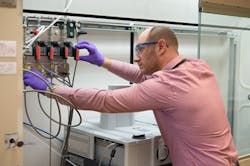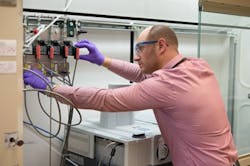Vanadium Catalyst Shows Promise
“Typically, catalyzing these reactions requires precious metals, like platinum, palladium or rhodium,” says Argonne chemist Max Delferro. “If we can make vanadium or another abundant metal as catalytically active as the noble metals, we can create dramatic cost savings in these very common and commercially important catalytic processes,” he adds.
Argonne chemist Max Delferro has developed an unusually active form of vanadium for hydrogenation reactions. Source: Argonne National Laboratory.
However, getting vanadium to work as a catalyst requires several steps. It must be in its 3+ oxidation state and spread out evenly on the surface; clumping results in inactivity. In addition, the vanadium atoms must be “low-coordinated” for the target molecules to bind.
“Getting single-atom vanadium into this special configuration on metal oxide surfaces is not easy,” Delferro admits. “It requires the use of special synthetic techniques such as surface organometallic chemistry and atomic layer deposition.”
When Delferro and his team created the vanadium in this configuration, they saw a dramatic boost in catalytic activity. A recent article in Chemical Communications contains more details.
The next steps in their research involve better understanding the mechanism and kinetic studies of the catalyst. Knowing the catalyst’s limitations will allow them to design a better one, the researchers believe. “We have already started and hope to come out with a follow-up study in the next few months,” notes Delferro.
Movement on the surface does pose challenges: “In the beginning, the metal sites are isolated on the surface, but during operation, the catalysts tend to move on the surface and agglomerate,” explains Delferro.
While it is difficult to avoid movement, the researchers have a few ideas as to how to lock the vanadium and keep it isolated.
“Making the catalyst sintering-resistant is the goal — we’re trying to overcoat the single vanadium atom on the surface with atomic layer deposition that still leaves small exposed areas for the reagent to contact the catalyst. This process blocks the metal’s surface movement.”
In terms of synthesis, the catalyst is very scalable, and susceptibility to poisoning by O2 and H2O doesn’t pose a problem, says Delferro. “In industrial processing, say for polyethylene production, existing technology allows for productive use of air-sensitive catalysts in these processes. Air and water poisoning [of] catalysts isn’t seen as the limiting concern; the big concerns are activity and selectivity,” he adds.
The researchers also are trying to create a catalyst for dehydrogenation. “Due to the abundance of shale gas, there is an abundance of light alkanes — if you are able to selectively dehydrogenate the light alkanes to make olefin, that is a very valuable product. Olefin is the building block of everything from fuels to plastics. But it’s a difficult reaction and there are few examples of good existing catalysts; this reaction happens at high temperatures of 500 to 600°C.
“We have experience working with industry on common goals relating to the development of catalysts for hydrogenation and dehydrogenation, among other reactions, and we see this new vanadium system as offering potential for new unprecedented reactivities.”
To aid in their efforts, one of Argonne’s strategic initiatives involves deepening the laboratory’s capabilities for fundamental catalysis research, including the possible creation of a multidisciplinary center for advanced catalysis.This aims to further unite the laboratory’s portfolio of basic energy science and chemistry research with applied energy technologies to produce new discoveries and techniques that will form the basis of new intellectual property for transfer to the marketplace. Argonne is growing its engagement with outside partners for joint work, licensing and commercialization throughout the technological lifecycle, starting from catalyst synthesis, through testing and characterization, to scale-up.
The laboratory also is planning to create an advanced manufacturing facility to study the basic science of large-volume material and to further engage with companies by giving them kilograms of catalytic material to test in their pilot plants, says Delferro.

